
Godzilla is a fictional monster, or kaiju, that debuted in the eponymous 1954 film, directed and cowritten by Ishirō Honda. The character has since become an international pop culture icon, appearing in various media: 33 Japanese films produced by Toho Co., Ltd., five American films, and numerous video games, novels, comic books, and television shows. Godzilla has been dubbed the King of the Monsters, an epithet first used in Godzilla, King of the Monsters! (1956), the American localization of the 1954 film.
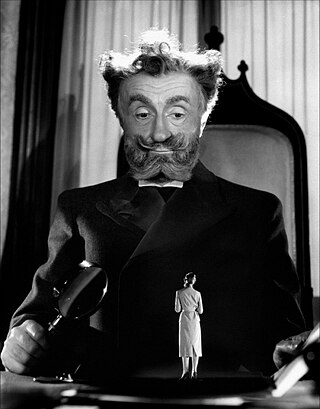
Special effects are illusions or visual tricks used in the theatre, film, television, video game, amusement park and simulator industries to simulate the imagined events in a story or virtual world.

Kaiju is a Japanese term that is commonly associated with media involving giant monsters. A subgenre of science fiction, it was created by Eiji Tsuburaya and Ishirō Honda. The term can also refer to the giant monsters themselves, which are usually depicted attacking major cities and battling either the military or other monsters.
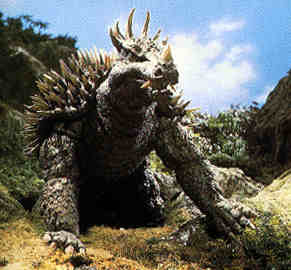
Anguirus is a fictional monster, or kaiju, which first appeared in Godzilla Raids Again (1955), the second film in the Godzilla franchise. Anguirus is the first monster to be shown engaging in combat with Godzilla in a film. Since then, the character has appeared conversely as an enemy and an ally of Godzilla in numerous films produced by Toho, including Destroy All Monsters, Godzilla vs. Gigan, Godzilla vs. Megalon, Godzilla vs. Mechagodzilla, and Godzilla: Final Wars. He has also appeared in other media, including comic books and video games.

An animatronic is a mechatronic puppet. They are a modern variant of the automaton and are often used for the portrayal of characters in films, games like fnaf and in theme park attractions.
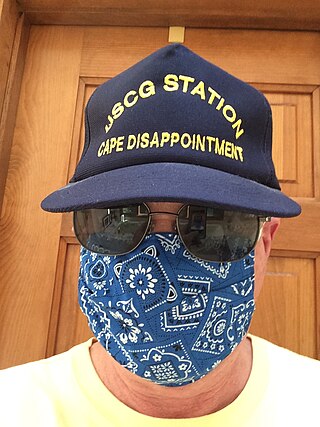
A disguise can be anything incognito which conceals one's identity or changes a person's physical appearance, including a wig, glasses, makeup, fake moustache, costume or other items. Camouflage is a type of disguise for people, animals and objects. Hats, glasses, changes in hair style or wigs, plastic surgery, and make-up are also used.
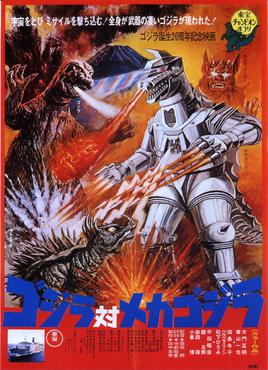
Godzilla vs. Mechagodzilla is a 1974 Japanese action-adventure kaiju film directed by Jun Fukuda, with special effects by Teruyoshi Nakano. Distributed by Toho and produced under their effects subsidiary Toho–Eizo, it is the 14th film of the Godzilla franchise, and features the fictional monster characters Godzilla, Anguirus, and King Caesar, along with the mecha character Mechagodzilla. The film stars Masaaki Daimon, Kazuya Aoyama, Gorō Mutsumi, and Akihiko Hirata, with Isao Zushi as Godzilla, Satoru Kuzumi as both Anguirus and King Caesar, and Kazunari Mori as Mechagodzilla. The film marks the first appearances of King Caesar and Mechagodzilla in the franchise.

Godzilla vs. Gigan, is a 1972 Japanese kaiju film directed by Jun Fukuda, written by Shinichi Sekizawa, and produced by Tomoyuki Tanaka, with special effects by Teruyoshi Nakano. Distributed by Toho and produced under their effects-based subsidiary Toho-Eizo, it is the 12th film in the Godzilla franchise, and features the fictional monster characters Godzilla, Gigan, Anguirus, and King Ghidorah. The film stars Hiroshi Ishikawa, Yuriko Hishimi, Tomoko Umeda, and Minoru Takashima, alongside Haruo Nakajima as Godzilla, Kenpachiro Satsuma as Gigan, Koetsu Omiya as Anguirus, and Kanta Ina as King Ghidorah. It is the last film in which Godzilla was portrayed by Nakajima after playing the character since the original 1954 film; he subsequently retired from suit acting.
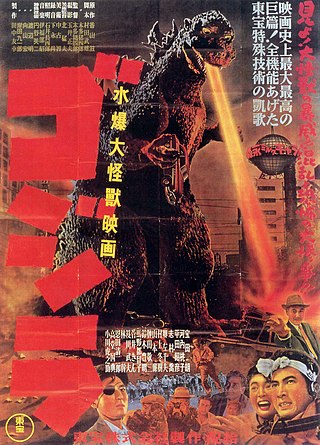
Tokusatsu is a Japanese term for live-action films or television programs that make heavy use of practical special effects. Credited to special effects director Eiji Tsuburaya, tokusatsu mainly refers to science fiction, war, fantasy, or horror media featuring such technology but is also occasionally dubbed a genre itself. Its contemporary use originated in the Japanese mass media around 1958 to explain special effects in an easy-to-understand manner and was popularized during the "first monster boom" (1966-1968). Prior to the monster boom, it was known in Japan as Tokushu gijutsu or shortened Tokugi.

Godzilla vs. Destoroyah is a 1995 Japanese kaiju film directed by Takao Okawara, with special effects by Kōichi Kawakita. Distributed by Toho and produced under their subsidiary Toho Pictures, it is the 22nd installment in the Godzilla franchise, and is the seventh and final film in the franchise's Heisei period. The film features the fictional monster characters Godzilla, Godzilla Junior and Destoroyah, and stars Takuro Tatsumi, Yōko Ishino, Yasufumi Hayashi, Sayaka Osawa, Megumi Odaka, Masahiro Takashima, Momoko Kōchi and Akira Nakao, with Kenpachiro Satsuma as Godzilla, Hurricane Ryu as Godzilla Junior, and Ryo Hariya as Destoroyah.
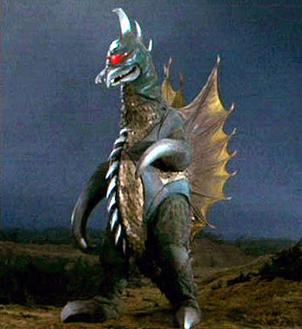
Gigan is a kaiju from Toho's Godzilla franchise who first appeared in Godzilla vs. Gigan. Gigan is a space monster resembling a species of reptile who was turned into a cyborg by the Nebulans. Gigan sports a huge buzzsaw in its frontal abdominal region and large metallic hooks for hands. Gigan is considered one of Godzilla's most brutal and violent opponents, and the first kaiju in the Toho sci-fi series to make him bleed. Complex listed the character as No. 2 on its "The 15 Most Badass Kaiju Monsters of All Time" list.

Zilla is a fictional monster, or kaiju, in Toho Co., Ltd.'s Godzilla media franchise. The character first appeared in Godzilla (1998), released by TriStar Pictures. It was initially created as a reimagining of Godzilla but was later re-branded as a separate character. Patrick Tatopoulos designed it after iguanas with a slim theropod appearance rather than the thick, bipedal designs of Toho's Godzilla. TriStar's Godzilla, both the film and character, were negatively received by fans and critics. In 2004, it was featured in Toho's Godzilla: Final Wars as "Zilla". Afterwards, Toho trademarked new incarnations as Zilla, with only the iterations from the 1998 film and animated series retaining the Godzilla copyright and trademark.

Godzilla Junior is a kaiju which first appeared in Toho's 1993 film Godzilla vs. Mechagodzilla II.

KyodaiHero is a television subgenre in tokusatsu that involves Japanese superheroes or robots either with the ability to grow to immense heights to fight giant monsters or who are originally giant as a part of their lives. The Kyodai Hero is the mainstream superhero genre that is widely popular in Japan. The first and most famous Kyodai hero is Ultraman who made his debut in 1966. Since then, Ultraman has helped spawn the Kyodai hero genre with countless shows, franchises and films such as Go! Godman and Iron King.
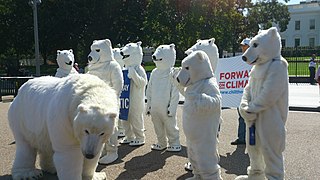
Bear suits are a type of costumed character or creature suit resembling a bear. The first bear suits worn by humans were used in shamanic ritual practices by native peoples. In the modern day, they are a popular choice of mascot, and both stylized and realistic bear suits are commonly used in film and on stage, due to the bear's prominent role in the arts and entertainment. Specific types of bear suits are also used in activism, such as polar bear suits to draw attention to the threat of global warming. Bear suits are also commonplace in the furry community.

A monster movie, monster film, creature feature or giant monster film is a film that focuses on one or more characters struggling to survive attacks by one or more antagonistic monsters, often abnormally large ones. The film may also fall under the horror, comedy, fantasy, or science fiction genres. Monster movies originated with adaptations of horror folklore and literature.
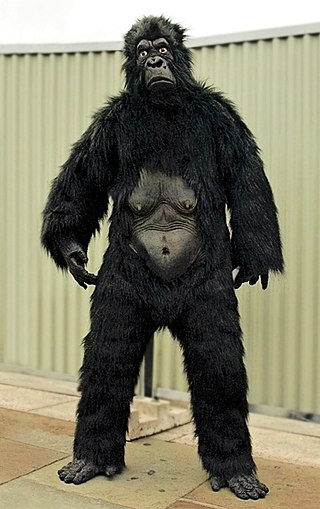
Gorilla suits are a type of creature suit resembling a gorilla. The gorilla suit is a popular Halloween and costume party costume, and is also used as a source of humour, while more realistic suits have been used both to represent real gorillas in film and on stage.
Bob Burns is an American actor, consultant, producer, archivist and historian of props, costumes, and other paraphernalia from science fiction, fantasy, and horror motion pictures. He is best known for his work with and collection of movie props, particularly from horror and science-fiction movies. He has also had numerous smaller acting roles in movies, including Tracy the Gorilla in the 1975 television show The Ghost Busters.
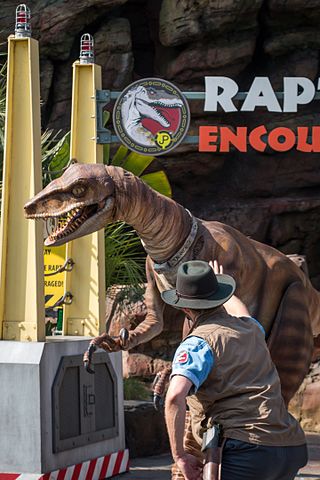
Dinosaur suits are a type of costumed character or creature suit resembling a dinosaur. Dinosaur suits are also called dinosaur costumes. Such costumes were used in film and television and as mascots for decades, reflecting dinosaurs' prominence in the arts and entertainment. Usually operators use two cable-pulled handle to control the motions. Realistic dinosaur suits also gained popularity for live shows following the success of Walking with Dinosaurs − The Arena Spectacular. An experienced performer can make lifelike movements with a dinosaur suit. They are also used in theme parks and in an educational context at various museums. Inflatable dinosaur suits have been used for pranks, gags, and protests.

Tom Woodruff Jr. is an American actor, director, producer and special effects supervisor. He won an Academy Award for Best Special Effects for his work on the 1992 dark fantasy film Death Becomes Her; that same year he was also nominated for the same award for Alien 3.

























